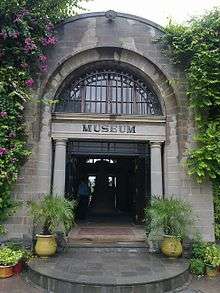Taxila Museum
| ٹیکسلا متحف | |
 Taxila Museum Entrance | |
| Established | 1918 |
|---|---|
| Location | Taxila, Punjab, Pakistan. |
| Type | Archaeological and historical |

Taxila Museum (Urdu: ٹیکسلا متحف) is located at Taxila, Punjab, Pakistan.
Introduction
Taxila Museum is situated in Taxila a tehsil of Rawalpindi. This is a site museum and its collection mainly focuses on Gandharan art. These sites at Taxila date back to 600 or 700 BC.
History
Construction of Taxila museum started in 1918, its foundation stone laid by Lord Chelmsford, Viceroy of India in 1918. Construction was concluded in 1928 and the museum was opened for public by Sir Habibullah then the Minister for Education. Sir John Marshall who was going to be retired from the post of Director General of the Archaeological Survey of India in 1928, could not complete its original plan. The government of Pakistan constructed the northern gallery in 1998.
Collection and displays
There are some 4000 objects displayed, including stone, stucco, terracotta, silver, gold, iron and semiprecious stones. Mainly the display consists of objects from the period 600 B.C to 500 AD. Buddhist, Hindu and Jain religions are well represented through these objects discovered from three ancient cities and more than two dozen Buddhist stupas and monasteries and Greek temples in the region.
Gandharan art
Taxila Museum has one of the most significant and comprehensive collections of stone Buddhist sculpture from the first to the seventh centuries in Pakistan (known as Gandharan art. The core of the collection comes from excavated sites in the Taxila Valley, partiuclary the excations of Sir John Marshall. Other objects come from excavated sites elsewhere in Gandhanra, from donations such as the Ram Das Collection, or from material confiscated by the police and custom authorities. The whole collection contains more than 1400 objects, and 409 have been published[1]
Numismatic collection
The Taxila Museum is a site museum and is the repository for the majority of the numismatic material found during archaeological work in Taxila. Digging began in 1917 under John Marshall, then director of the Archaeological Survey of India, and continued until 1934. Since those excavations, work has continued to the present day. The museum contains a large collection of coins from the period of the Indo-Greeks to the late Kushans. Some of these are published in Marshall's [2] original excavation reports, and an ongoing project exists to publish the full collection.[3]
See also
| Wikimedia Commons has media related to Taxila Museum. |
Notes
References
- Khan, G R (2007) "Kanishka Coins from Taxila" in Gandharan Studies Vol.1: 119ff
- Khan, G R (2008) "Gold Coins in the Cabinet of Taxila Museum, Taxila" in Gandharan Studies Vol.2: 39-61
- Khan, G R (2009) "Huvishka Coins from Taxila", Gandharan Studies, Vol. III, Peshawar, pp. 75–125.
- Khan, G R (2010) "Copper Coins of Vasudeva and His Successors from Taxila", Gandharan Studies Vol. IV, Peshawar, pp. 139–261.
- Khan, M A (2005) A Catalogue of the Gandhara Stone Sculptures in the Taxila Museum, 2 Volumes
- Marshall, J H (1951) Taxila: An Illustrated Account of Archaeological Excavations Carried out at Taxila under the Orders of the Government of India between the years 1917 and 1934. 3 Volumes. Cambridge University Press.
- Marshall, S.J. (2007) A Guide to Taxila, Karachi, 2007 (Rep.).
- Walsh, E.H.C. (1939) Punch – Marked Coins from Taxila, Memoirs of the Archaeological Survey of India, No. 59, Delhi.